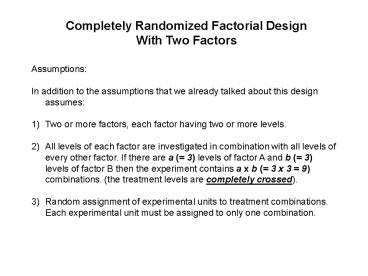Assumptions: - PowerPoint PPT Presentation
1 / 13
Title:
Assumptions:
Description:
Title: Slide 1 Author: Zaid Abdo Last modified by: Zaid Abdo Created Date: 9/12/2006 9:23:34 PM Document presentation format: On-screen Show (4:3) Company – PowerPoint PPT presentation
Number of Views:74
Avg rating:3.0/5.0
Title: Assumptions:
1
Completely Randomized Factorial Design With Two
Factors
- Assumptions
- In addition to the assumptions that we already
talked about this design assumes - Two or more factors, each factor having two or
more levels. - All levels of each factor are investigated in
combination with all levels of every other
factor. If there are a ( 3) levels of factor A
and b ( 3) levels of factor B then the
experiment contains a x b ( 3 x 3 9)
combinations. (the treatment levels are
completely crossed). - Random assignment of experimental units to
treatment combinations. Each experimental unit
must be assigned to only one combination.
2
Completely Randomized Factorial Design With Two
Factors
Assignment of Experimental Units Assume we have
3 factors. Factor A has three levels a1 , a2 and
a3 and factor B has three levels b1, b2, and b3
then the layout of the completely randomized
design is as follows
a1b1 a1b2 a1b3 a2b1 a2b2 a2b3 a3b1 a3b2 a3b3
y111 y112 y113 y11n y121 y122 y123 y12n y131 y132 y133 y13n y211 y212 y213 y21n y221 y222 y223 y22n y231 y232 y233 y23n y311 y312 y313 y31n y321 y322 y323 y32n y331 y332 y333 y33n
Total sample is nab n(3)(3) randomly assigned
to the different combinations, with a minimum n
1 (in this case we have to assume no interaction
between the different factor levels).
3
Completely Randomized Factorial Design With Two
Factors
Linear Model
4
Completely Randomized Factorial Design With Two
Factors
yijk Response of the kth experimental unit in the ij factor combination.
m The grand mean of all factor combinations population-means.
ai Factor effect for population i, and should obey the condition
bj Factor effect for population i, and should obey the condition
(ab)ij Joint effect of factor levels i and j, and should obey both
eijk The error effect associated with Yijk and is equal to
5
Completely Randomized Factorial Design With Two
Factors
Means
A\B b1 b2 b3 Grand Means
a1 m11 m12 m13 m1.
a2 m21 m22 m23 m2.
a3 m31 m32 m33 m3.
Grand means m.1 m.2 m.3 m
6
Completely Randomized Factorial Design With Two
Factors
Hypotheses
7
Completely Randomized Factorial Design With Two
Factors
Means
A\B b1 b2 b3 Grand Means
a1
a2
a3
Grand means
8
Completely Randomized Factorial Design With Two
Factors
What are we comparing?
A/B b1 b2 b3 Grand Means
a1 m11 m a1 b1 (ab)11 m12 m a1 b2 (ab)12 m12 m a1 b3 (ab)13 m1. m a1
a2 m23 m a2 b1 (ab)21 m23 m a2 b2 (ab)22 m23 m a2 b3 (ab)23 m2. m a2
a3 m33 m a3 b1 (ab)31 m33 m a3 b2 (ab)32 m33 m a3 b3 (ab)33 m3. m a3
Grand means m.1 m b1 m.2 m b2 m.3 b3 m
9
Completely Randomized Factorial Design With Two
Factors
Hypotheses
10
Completely Randomized Factorial Design With Two
Factors
Means
A\B b1 b2 b3 Grand Means
a1
a2
a3
Grand means
Where
11
Completely Randomized Factorial Design With Two
Factors
12
Completely Randomized Factorial Design With Two
Factors (Fixed Effects)
13
Completely Randomized Factorial Design With Two
Factors (Fixed Effects)































